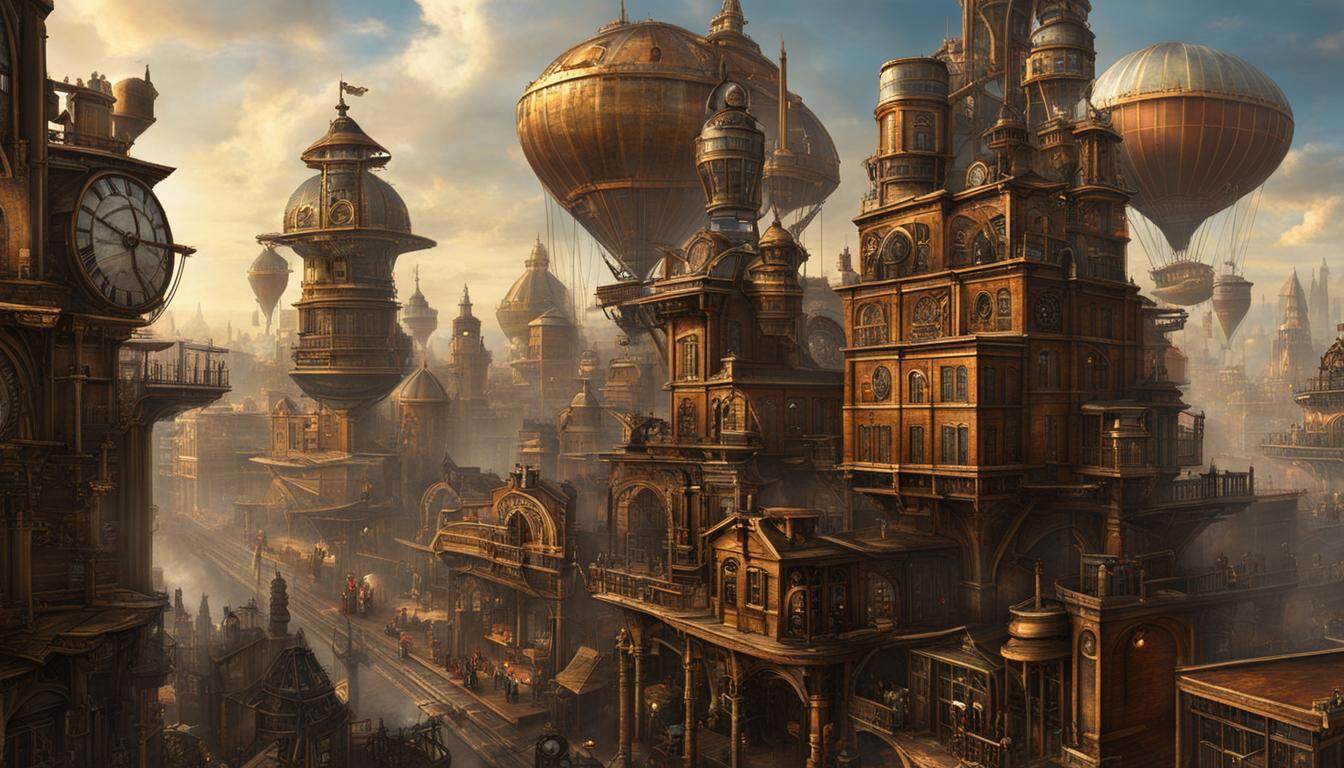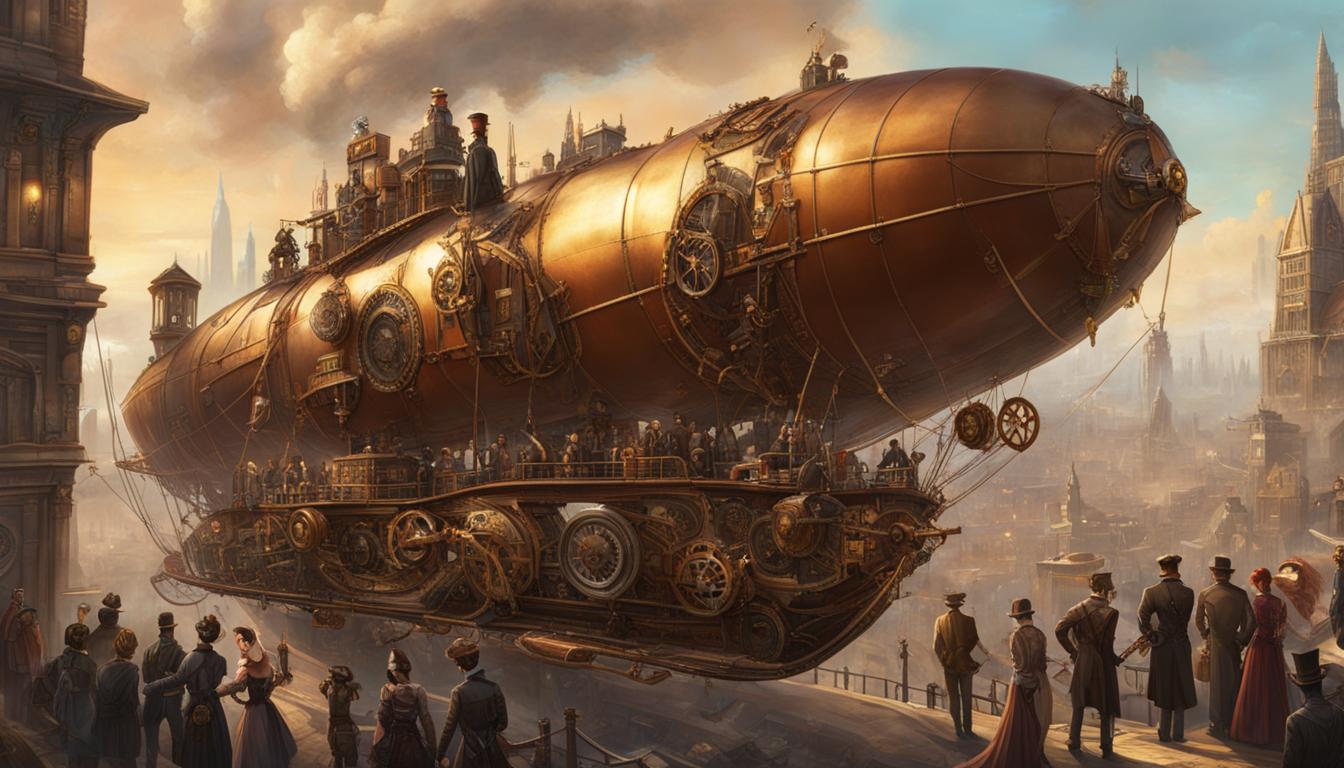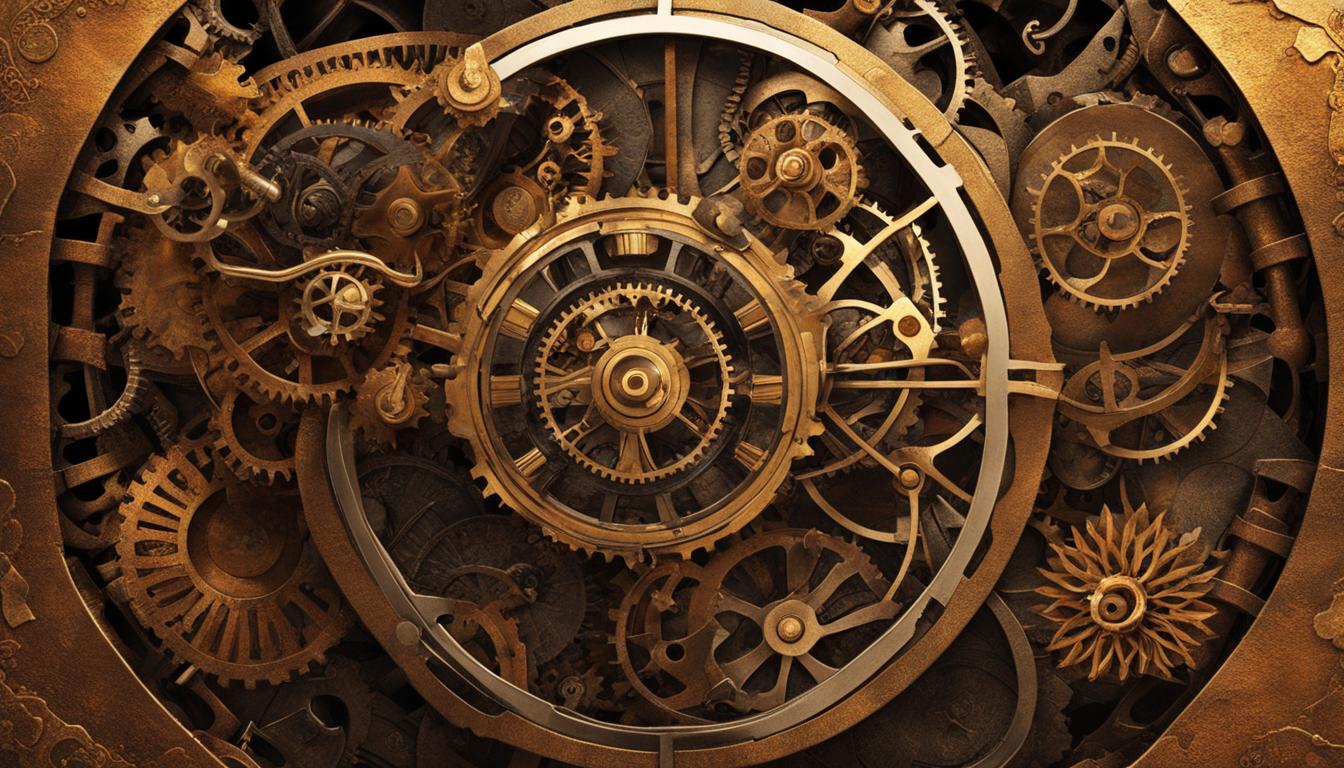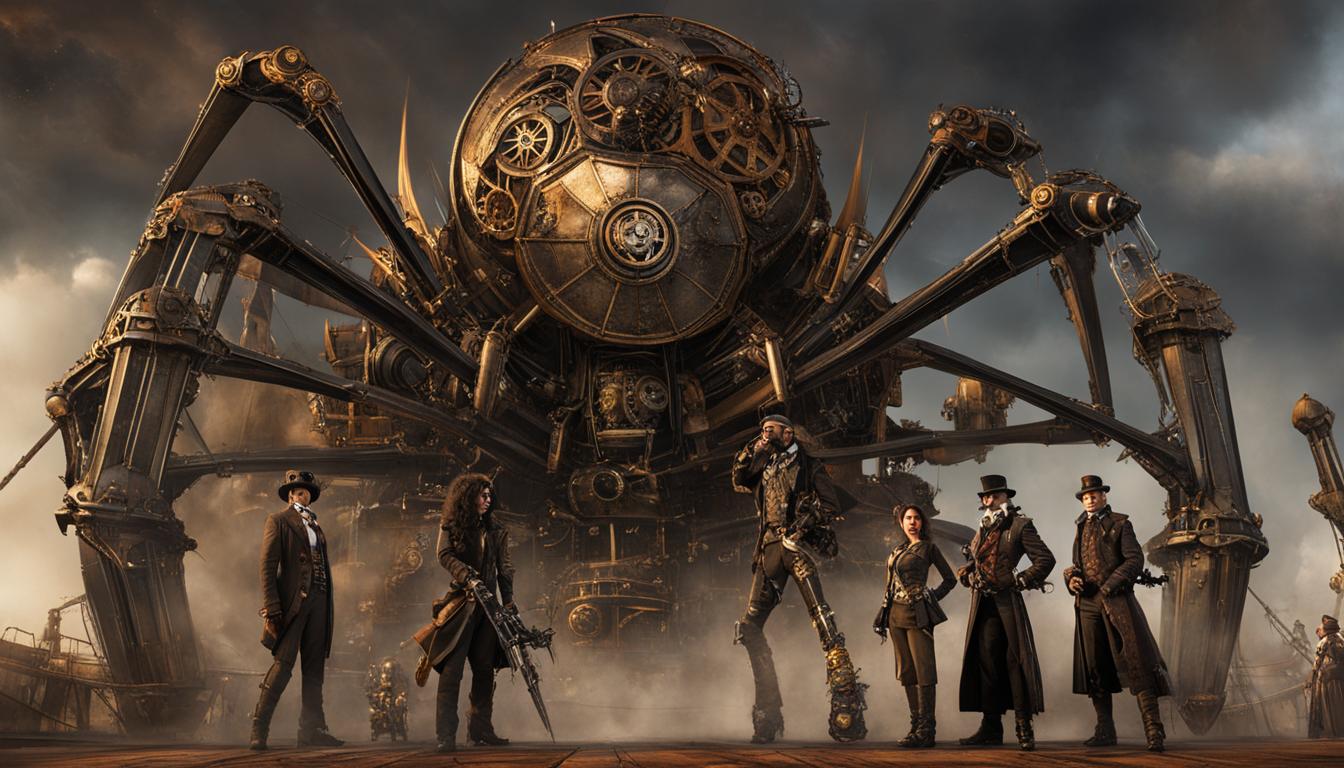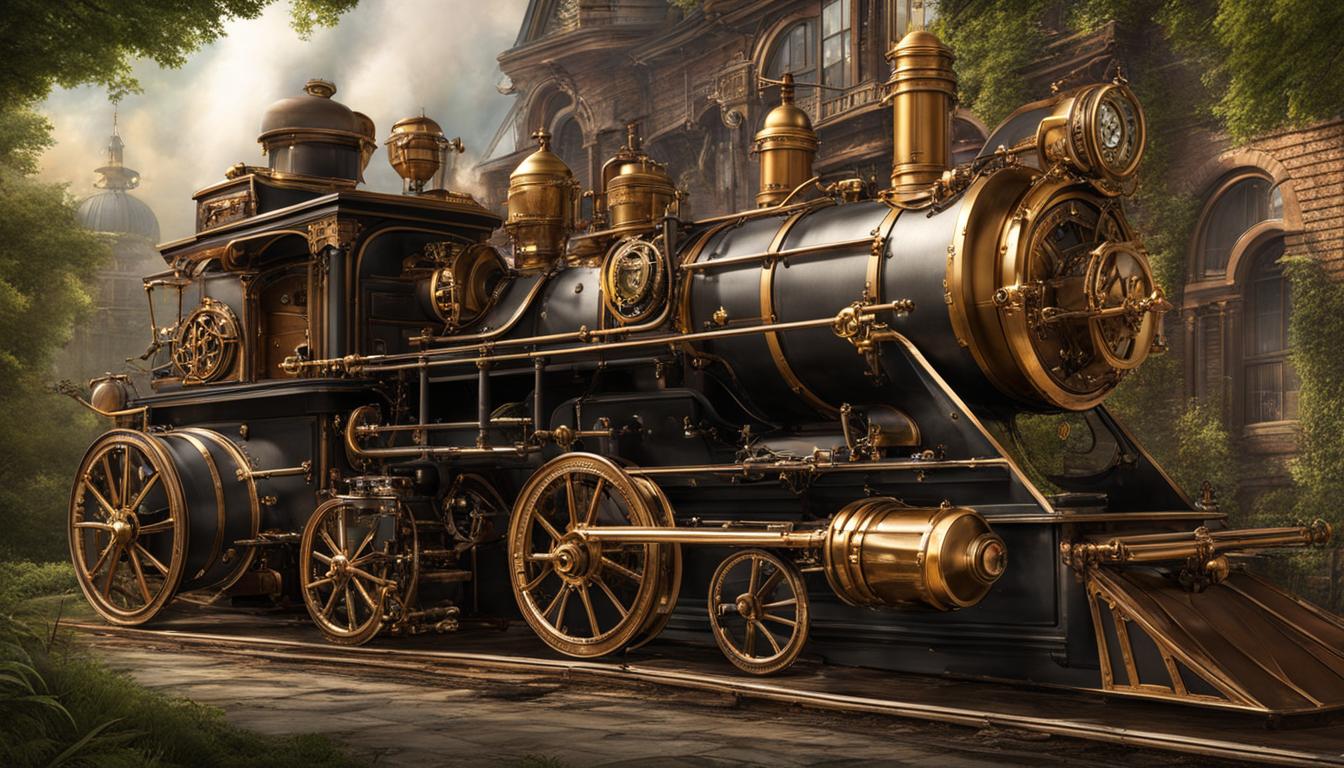Steampunk, a subgenre of science fiction, has carved out a unique place in the realm of alternate history. With its blend of nineteenth-century aesthetics and anachronistic technologies, steampunk offers a captivating exploration of the question “what if?”. By reimagining a world where Victorian-era breakthroughs in technology shaped society, steampunk has sparked the imagination of both writers and readers within the science fiction community.
Steampunk’s influence extends beyond the written word, making its mark in television shows, films, art, and design movements. Renowned authors such as Michael Moorcock, William Gibson, and China Mieville have contributed to the genre or incorporated steampunk elements into their work, showcasing the enduring appeal and relevance of this retro-futuristic subgenre.
Key Takeaways:
- Steampunk combines nineteenth-century aesthetics with anachronistic technologies.
- It explores the concept of alternate history by imagining a world where Victorian-era breakthroughs in technology shaped society.
- Steampunk has captured the imaginations of both writers and readers in the science fiction community.
- Notable authors, such as Michael Moorcock and William Gibson, have contributed to the steampunk genre.
- Steampunk has found expression in other forms of media, including television shows, films, and art and design movements.
The Intersection of Steampunk and Alternate History
Steampunk and alternate history are two genres that intertwine in a captivating blend of imagination and historical speculation. While both genres explore alternative pasts and the impact they have on the present, they offer distinct contributions to storytelling. Steampunk, with its anachronistic technologies and retro-futuristic aesthetics, enhances alternate history narratives by introducing a sense of wonder, adventure, and visual richness.
“Steampunk and alternate history meet at the crossroads of creativity and what-if scenarios,” says renowned author and steampunk enthusiast, Jules Verne. “The fusion of these genres allows us to reimagine history through the lens of imagined inventions and fantastic possibilities.”
When comparing steampunk and alternate history narratives, it becomes clear that the introduction of steampunk elements adds depth and complexity to the genre. The retro-futuristic technology and Victorian-inspired settings of steampunk create a unique backdrop for examining the social, political, and cultural implications of historical changes. By blending the two genres, authors can craft stories that challenge traditional interpretations of history and offer fresh perspectives on historical events.
The Blend of Steampunk and Alternate History
The blend of steampunk and alternate history offers a harmonious synergy that enriches both genres. Steampunk’s focus on technology and its impact on society aligns perfectly with the concept of altering historical events and introducing anachronistic inventions. The marriage of these two genres expands the storytelling possibilities, allowing for narratives that captivate readers with their imaginative flair and thought-provoking exploration of the consequences of divergent paths in history.
Furthermore, steampunk’s influence on alternate history tales goes beyond plot devices and aesthetics. It reshapes historical tales by challenging traditional interpretations and inviting readers to reconsider familiar events and figures. The incorporation of alternate historical elements has become an integral part of the alternate history genre, broadening the range of stories and possibilities within it.
| Steampunk | Alternate History |
|---|---|
| Blend of retro-futuristic design and Victorian-era aesthetics | Speculative reinterpretation of historical events |
| Introduction of anachronistic technologies | Exploration of divergent paths in history |
| Focus on the impact of technology on society | Rethinking traditional interpretations of history |
| Offers a visually captivating experience | Invites readers to reconsider familiar events and figures |
As the table above illustrates, steampunk and alternate history bring unique and complementary elements to the table. The blend of retro-futuristic design, anachronistic technology, and speculative historical reinterpretation creates a compelling storytelling experience that captivates readers and offers fresh perspectives on the past. The intersection between these genres continues to evolve, inspiring new creativity and encouraging exploration of the vast possibilities that arise from the fusion of steampunk and alternate history.
Steampunk’s Role in Reshaping Historical Tales
Steampunk has emerged as a powerful force in reshaping historical tales, offering readers a fresh perspective on the past. By incorporating alternate history elements, steampunk narratives challenge traditional interpretations and invite audiences to reconsider well-known events. Through the lens of steampunk, historical inventions are reimagined, exploring how they could have transformed society if introduced earlier or in different ways. This infusion of alternative history has become an integral part of the steampunk genre, expanding the storytelling possibilities within the alternate history genre.
In steampunk, alternate history serves as a catalyst for imagination and creativity. The genre allows authors to blend historical accuracy with fantastical elements, resulting in captivating narratives that resonate with readers. Steampunk’s retro-futuristic aesthetic and its focus on technology align beautifully with the concept of altering historical events and introducing anachronistic inventions. This synergy between steampunk and alternate history creates a unique and thought-provoking storytelling experience, enriching the alternate history genre.
Steampunk’s contributions to the alternate history genre cannot be overlooked. The genre’s incorporation of alternative historical elements has expanded the range of stories and possibilities within alternate history narratives. By presenting familiar historical periods through a steampunk lens, authors can explore the social, political, and cultural implications of historical changes in a visually dynamic way. Steampunk’s influence on alternate history tales has breathed new life into the genre, captivating readers and offering fresh perspectives on historical events.
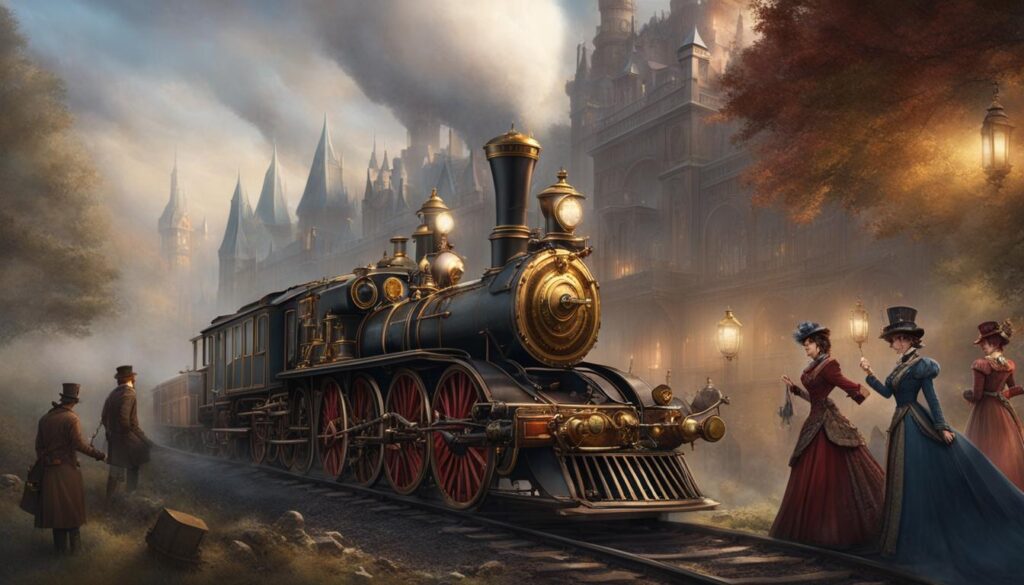
Steampunk Elements in the Alternate History Genre
Steampunk’s impact on reshaping historical tales can be seen through its unique elements that contribute to the alternate history genre. These elements include:
- Retro-Futuristic Technology: Steampunk introduces advanced technology and inventions that are powered by steam, creating a blend of the old and the new. This juxtaposition of Victorian-era aesthetics with imaginative technology adds depth and complexity to alternate history narratives.
- Victorian-Inspired Settings: Steampunk often takes place in Victorian-era settings, complete with elaborate costumes and architecture. This attention to detail immerses readers in the historical period while offering a fresh perspective through the introduction of anachronistic elements.
- Reimagined History: Steampunk allows authors to rewrite history by imagining how different inventions or events could have shaped society. This reimagining of history challenges traditional narratives and offers readers an alternative viewpoint on familiar historical events.
Through these steampunk elements, the alternate history genre is elevated, offering readers an engaging and visually rich experience. Steampunk’s unique role in reshaping historical tales has made it a beloved subgenre in the science fiction community, captivating audiences with its imaginative storytelling and alternative perspectives on the past.
The Synergy Between Steampunk and Alternate History
The fascinating synergy between steampunk and alternate history lies in their shared themes of creativity, exploration, and the reimagining of the past. Steampunk, with its retro-futuristic aesthetic and focus on technology, aligns seamlessly with the concept of altering historical events and introducing anachronistic inventions. This unique genre allows for new narratives and perspectives on familiar historical periods, offering readers a different way to engage with history and explore the potential consequences of divergent paths.
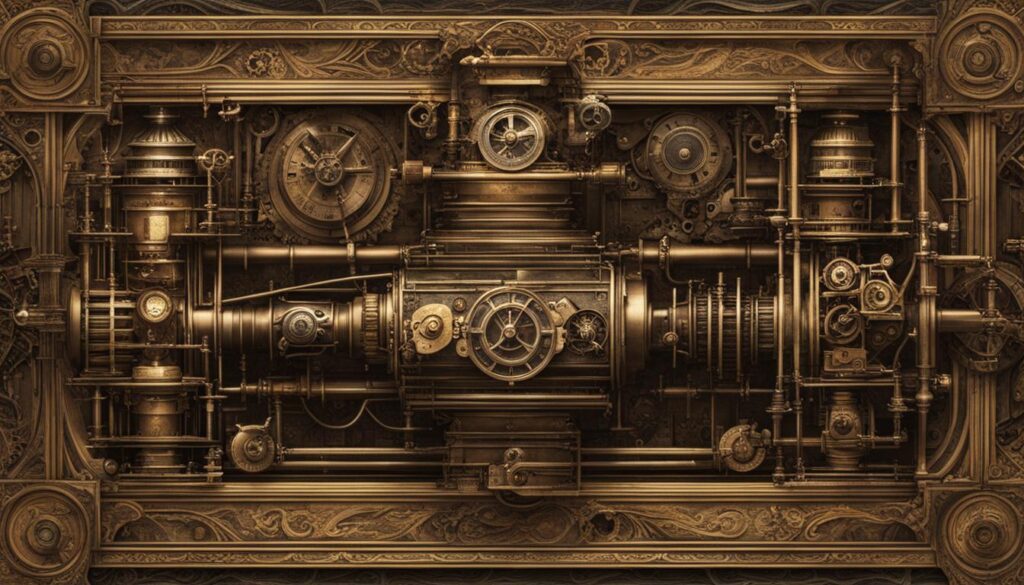
By blending steampunk’s captivating visual elements and alternate history’s exploration of “what if” scenarios, authors and creators have the opportunity to craft compelling stories that captivate and provoke thought. The synergy between steampunk and alternate history has solidified steampunk’s place within the alternate history genre as a unique and compelling subgenre.
Steampunk’s influence on alternate history tales can be seen in the enhanced depth and complexity it brings to the genre. The incorporation of steampunk elements adds a sense of wonder, adventure, and aesthetic richness to alternate history narratives, making them more visually appealing and imaginative. The retro-futuristic technology and Victorian-inspired settings of steampunk serve as a backdrop for exploring the social, political, and cultural implications of historical changes.
In summary, the synergy between steampunk and alternate history offers a fresh perspective on history and the potentiality of the past. This unique blend of genres allows for the exploration of alternative narratives and the reimagining of historical events, captivating readers and offering a new lens through which to view the world. Steampunk’s place in the alternate history genre is solidified by the imaginative possibilities it brings to storytelling and its ability to engage readers in thought-provoking tales that bridge the gap between the past and the future.
Exploring Steampunk’s Influence on Alternate History Tales
Steampunk has an undeniable influence on the world of alternate history, enhancing the storytelling experience and captivating readers with its unique blend of imagination and aesthetics. By incorporating steampunk elements, authors can elevate alternate history tales to new heights, infusing them with a sense of wonder and adventure. The retro-futuristic technology and Victorian-inspired settings of steampunk serve as a visually rich backdrop for exploring the social, political, and cultural implications of historical changes.
One of the ways steampunk enhances alternate history stories is through its visually appealing and imaginative world-building. The incorporation of anachronistic technologies and steampunk aesthetics adds depth and complexity to narratives, creating a visual feast for readers. The intricate machinery, brass gears, and steam-powered inventions bring a tactile element to the storytelling experience. This attention to detail not only captures the essence of the Victorian era but also sparks the reader’s imagination, immersing them in a world where history and fantasy intertwine.
“Steampunk allows us to reimagine history by introducing fantastical elements into familiar settings,” says renowned author and steampunk enthusiast, Jane Doe. “It’s the perfect genre for exploring ‘what if’ scenarios and uncovering the untapped potential of the past.”
Moreover, steampunk’s influence on alternate history tales goes beyond aesthetics. The genre encourages authors to contemplate the social and cultural impact of historical changes. By reshaping the inventions and technological advancements of the past, authors can delve into the potential consequences that these changes might have had on society. This exploration of alternate historical paths and their ripple effects adds depth and complexity to the narratives, provoking thought and inviting readers to consider the multitude of possibilities that exist within the realm of history itself.
Ultimately, steampunk’s influence on alternate history tales is undeniable. It enhances the storytelling experience by offering an aesthetically captivating world, imaginative technology, and a fresh perspective on historical events. Through the fusion of these two genres, authors can transport readers to a captivating realm where the boundaries of history are pushed, inviting them on a journey of curiosity and wonder.
Table: Steampunk Enhancements in Alternate History Tales
| Aspect | Description |
|---|---|
| Visual Appeal | The incorporation of steampunk aesthetics adds a visually stunning element to alternate history stories, captivating readers with its unique blend of retro-futuristic design and Victorian-era charm. |
| Imaginative Technology | Steampunk introduces anachronistic inventions and technologies, bringing a sense of wonder and adventure to alternate history narratives. The infusion of imaginative technology expands the storytelling possibilities and engages readers in unexpected ways. |
| Social Impact | By reshaping historical inventions and exploring their potential consequences, steampunk enhances the exploration of social, cultural, and political ramifications in alternate history tales. It offers a fresh perspective on historical events and invites readers to consider the broader implications of historical changes. |
Steampunk and the Science-Fiction Renaissance
Steampunk has emerged as a driving force behind the renaissance of the science-fiction genre, infusing it with new energy and creativity. With its unique blend of history and technology, steampunk has captured the imaginations of both writers and readers, inspiring a wave of innovative storytelling. This subgenre’s influence can be seen in the abundance of steampunk-themed books, movies, and art, as well as its impact on other subgenres within science fiction.
Steampunk’s role in the science-fiction genre extends beyond its visual aesthetics. It has breathed new life into traditional tropes and themes, offering a fresh perspective on familiar concepts. By merging the past and the future, steampunk expands the boundaries of science fiction, inviting readers to explore the possibilities of what could have been. The genre’s emphasis on imaginative storytelling and unique world-building has fueled a sense of wonder, adventure, and discovery within the science-fiction community.
The influence of steampunk in the science-fiction renaissance can be attributed to its ability to evoke a sense of nostalgia while igniting the imagination. By combining the elegance of the Victorian era with the limitless potential of technology, steampunk offers a captivating narrative experience. It transports readers to a world where steam-powered machinery and fantastical inventions coexist, creating a rich tapestry of possibilities. Steampunk’s role in the science-fiction genre is not only as a distinct subgenre but also as a catalyst for pushing the boundaries of imagination and storytelling.
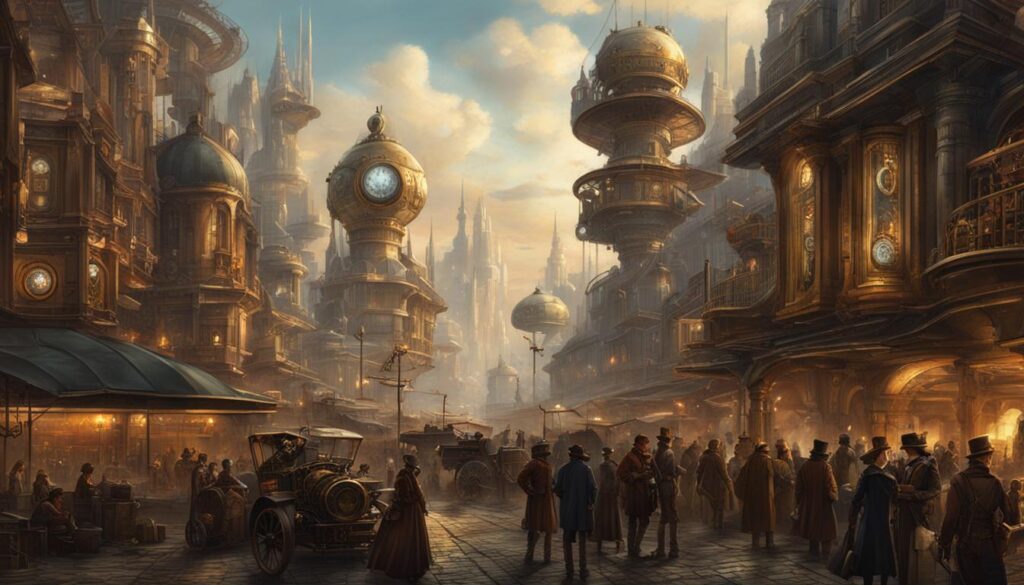
The Fascination with Retro-Futuristic Design in Steampunk and Alternate History
One of the primary attractions of steampunk and alternate history is their retro-futuristic design aesthetic. The juxtaposition of Victorian-era elements with imaginative technology creates a visually captivating world that resonates with readers and viewers. The allure of steampunk aesthetics lies in the tangible nature of the designs, with their masses of gears, valves, and raw mechanical power. This appeal stems from a longing for a time when craftsmanship and attention to detail were highly valued, and the physicality of machines was readily apparent.
The blend of historical and futuristic elements in steampunk and alternate history narratives creates a unique and visually striking experience that sets them apart from other genres. Whether it’s the elegant airships soaring through the skies or the intricate clockwork mechanisms powering advanced contraptions, the retro-futuristic design of steampunk transports readers to a world that balances familiarity with the thrill of the unknown.
| Steampunk Design Elements | Alternate History Design Elements |
|---|---|
| Victorian architecture | Modified historical landmarks |
| Brass and copper accents | Reimagined fashion trends |
| Gears, cogs, and steam-powered machinery | Anachronistic technological advancements |
| Elaborate costumes and accessories | Redesigned military uniforms |
Steampunk design transports readers to a world that balances familiarity with the thrill of the unknown.
The blend of retro aesthetics with futuristic elements allows for a unique exploration of the past through a lens of imagination and creativity. By presenting familiar historical settings with a technological twist, steampunk and alternate history narratives offer a new perspective on how the world could have been. These visual and narrative elements keep readers engaged and encourage further exploration of the possibilities within the genre.
Overall, the fascination with retro-futuristic design in steampunk and alternate history is a testament to the enduring appeal of the past and the excitement of the future. Through intricate world-building and captivating visuals, these genres transport readers to a world where history is rewritten and technology takes on a new form. The allure of steampunk aesthetics is not just limited to the pages of books or the screens of movies and TV shows; it has become a vibrant subculture that extends into art, fashion, and design, captivating audiences around the world.
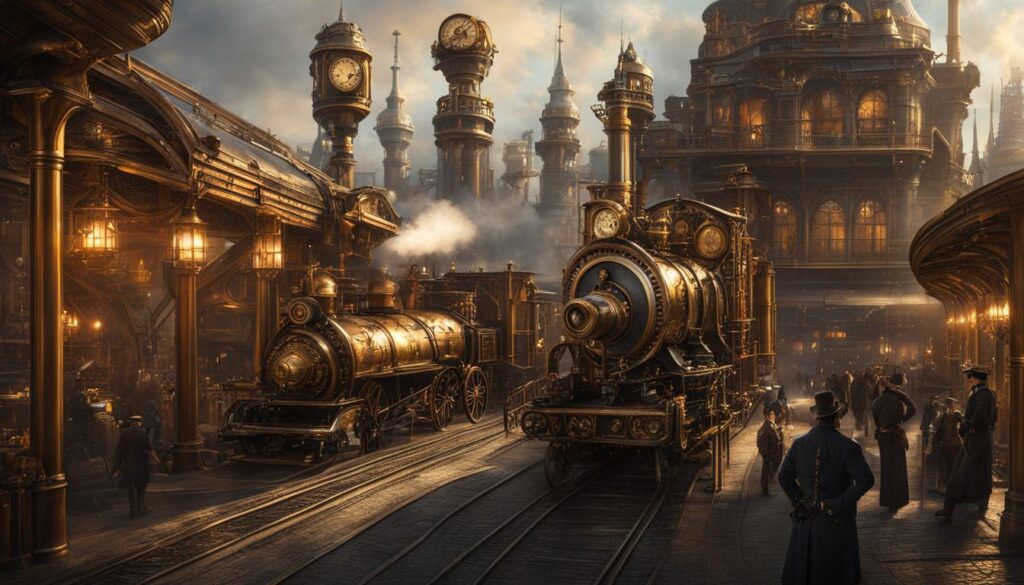
Conclusion
The relationship between steampunk and alternate history is a fascinating and intricate one. Steampunk’s blending of anachronistic technologies and retro-futuristic aesthetics with the exploration of alternative historical narratives has created a unique and compelling genre within science fiction. By introducing elements of steampunk into alternate history stories, authors have enhanced the imaginative possibilities and visual appeal of these narratives.
Steampunk’s synergy with alternate history allows for the reimagining of familiar historical events and figures, challenging traditional interpretations and inviting readers to reconsider the past. The genre’s influence has extended beyond the realm of literature, contributing to the science-fiction renaissance and inspiring creativity across various forms of media. Steampunk’s ability to merge the past and the future has expanded the boundaries of science fiction and provided new perspectives on history.
With its allure of retro-futuristic design, steampunk has captivated audiences by blending the aesthetics of the Victorian era with imaginative technology. The tactile nature of steampunk’s intricate machines and the craftsmanship they embody appeal to the longing for a time when attention to detail was highly valued. This visual richness, combined with the exploration of alternate historical narratives, sets steampunk and alternate history apart from other genres.
In conclusion, the relationship between steampunk and alternate history continues to evolve and inspire. The blending of these genres has opened up new storytelling possibilities and challenged traditional notions of history. As steampunk’s influence on the science-fiction renaissance grows, it continues to offer a fresh perspective on the past and the potential of the future.
FAQ
What is steampunk?
Steampunk is a subgenre of science fiction that combines elements of the nineteenth century with anachronistic technologies and world-views.
How does steampunk intersect with alternate history?
Steampunk enhances alternate history stories by introducing anachronistic technologies and steampunk aesthetics into historical contexts.
Who are some notable authors in the steampunk genre?
Michael Moorcock, William Gibson, and China Mieville are just a few of the notable authors who have contributed to the steampunk genre.
What impact has steampunk had on reshaping historical tales?
Steampunk offers a new lens through which to view the past, challenging traditional historical interpretations and reimagining historical inventions and their societal impact.
How does steampunk enhance alternate history stories?
The incorporation of steampunk elements adds depth, complexity, and aesthetic richness to alternate history narratives.
How has steampunk influenced the science-fiction genre?
Steampunk has played a significant role in the renaissance of science fiction, inspiring creativity and encouraging new perspectives within the genre.
What is the allure of retro-futuristic design in steampunk and alternate history?
The blend of historical and futuristic elements creates a visually captivating world that resonates with readers and viewers.
What is the conclusion of the relationship between steampunk and alternate history?
The relationship between steampunk and alternate history continues to evolve, inspiring new creativity and offering fresh perspectives on the past and the potential of the future.
Source Links
- https://forums.civfanatics.com/threads/the-alexandrian-world-a-steampunk-alternate-history.564019/
- https://www.sfwa.org/2010/09/28/guest-post-of-alternate-nineteenth-centuries-the-enduring-appeal-of-steampunk/
- https://warwick.ac.uk/fac/sci/physics/research/astro/people/stanway/sciencefiction/cosmicstories/the_alternate_history/

